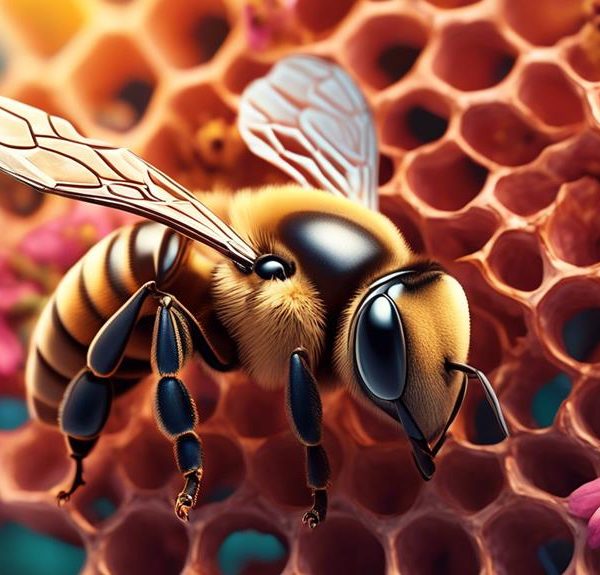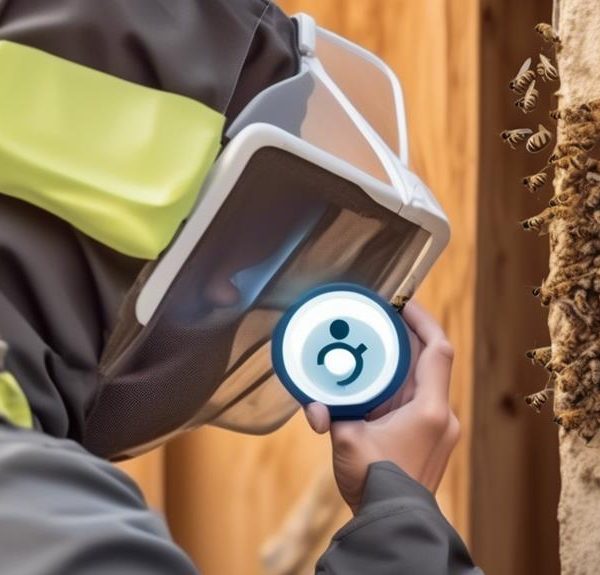Get the buzz on whether carpenter bees, the wood-boring insects, also contribute to the world's honey production.
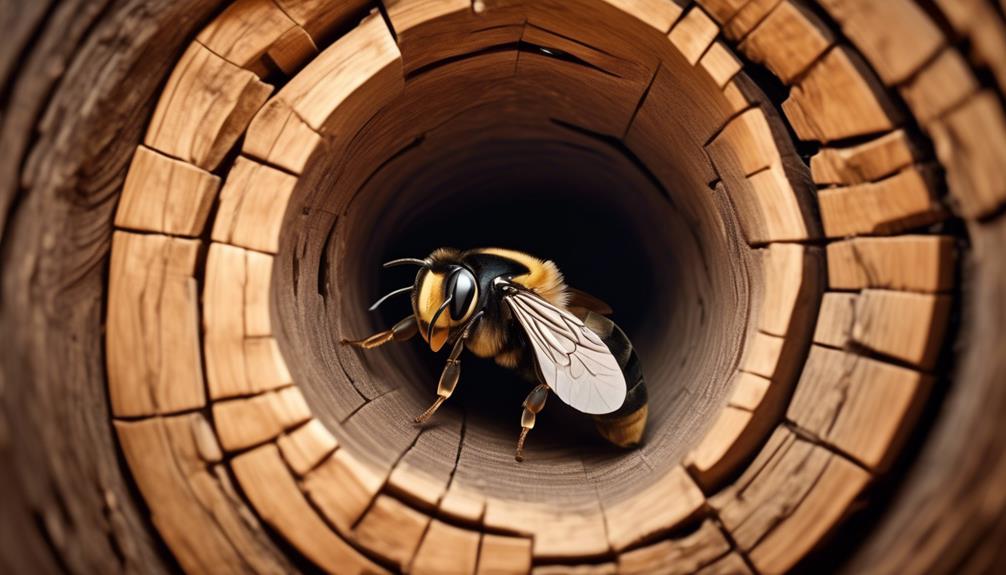
Do Carpenter Bees Make Honey?
Imagine, if you will, a world without the buzzing of bees or the sweetness of honey. You've probably encountered carpenter bees, with their shiny, black bodies and habit of boring into wood.
Now, you're wondering, do these lumberjacks of the insect world also produce honey like their cousins, the honey bees? Well, the answer isn't as straightforward as you might think. While they share some characteristics with honey bees, there are also some key differences that affect their honey-making abilities.
Intrigued? Let's explore this further.
Key Takeaways
- Carpenter bees, unlike honey bees, do not produce honey due to their solitary lifestyle.
- Carpenter bees lack the hive structure and wax glands necessary for honey production.
- Understanding this distinction is crucial for conservation efforts and biodiversity preservation.
- Carpenter bees play a vital role in the ecosystem as exceptional pollinators and contributors to soil health through their nesting habits.
Understanding Carpenter Bees
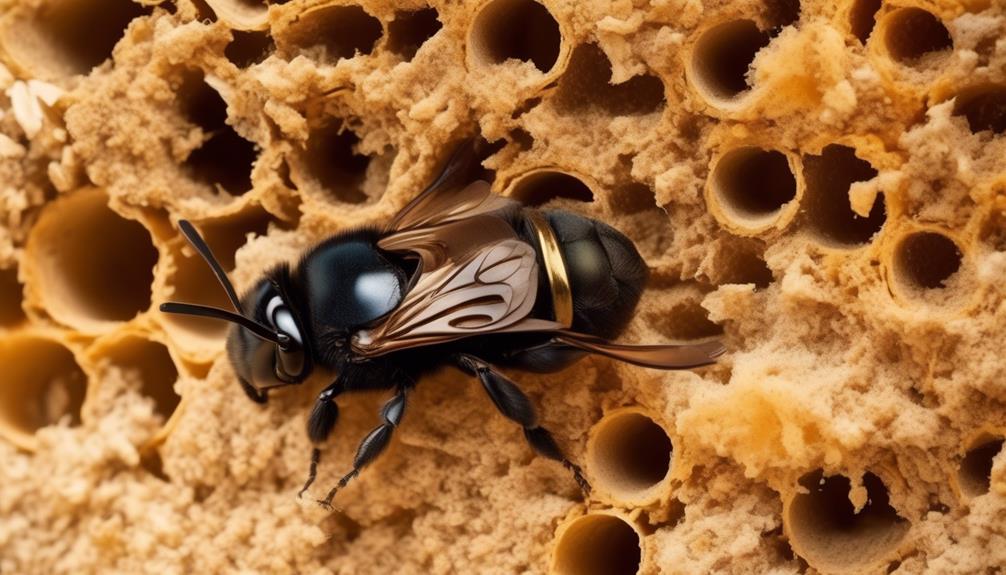
To truly appreciate the role of carpenter bees in honey production, you need to grasp their unique biology and intricate behaviors. Unlike honeybees, who live in large, social colonies, carpenter bees are solitary creatures. They're known for their remarkable ability to bore into wood, creating tunnels where they lay their eggs and store food. This solitary lifestyle impacts their honey production significantly.
Their biology is also distinctive. Carpenter bees are bigger and more robust than their honeybee counterparts. Their bodies are covered in a shiny, black integument, while honeybees have a more fuzzy, golden appearance. You'll notice the male carpenter bees are harmless, lacking a stinger, while females can sting but rarely do unless provoked.
Their behavior, though less social, is no less fascinating. Carpenter bees are excellent pollinators, often 'buzz pollinating' by vibrating their bodies at a frequency that dislodges pollen. This behavior is crucial for certain plants that honeybees can't effectively pollinate.
While carpenter bees don't produce honey in the quantities that honeybees do, they're an integral part of our ecosystem. Understanding their unique biology and behavior gives you better insight into their role in honey production.
The Diet of Carpenter Bees
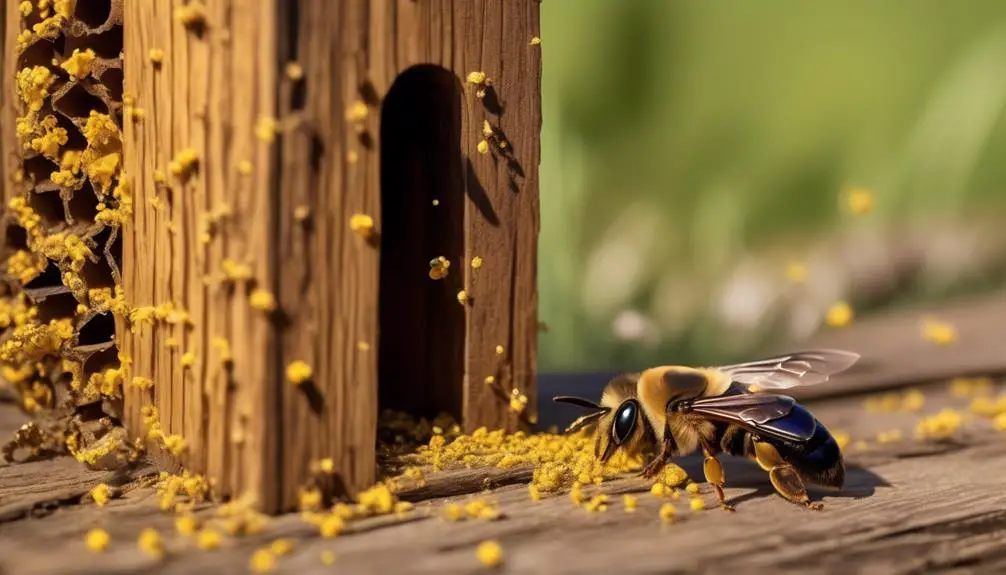
Diving into their diet, you'll find that carpenter bees, akin to other bee species, primarily feed on nectar and pollen from a variety of flowering plants. This diet is vital for their survival, as nectar provides them with the carbohydrates they need for energy, while pollen offers protein and fats for growth and development.
Unlike honey bees, carpenter bees don't produce honey, but they store a portion of their collected nectar as a food reserve. They also create a pollen ball, a mixture of pollen and nectar, for their larvae. The female bee prepares this nutritious meal, depositing it in the nest before laying an egg on it.
It's important to note that carpenter bees are indeed selective in their diet. They opt for specific plant species, favoring those that offer easily accessible nectar. In this regard, they're considered important pollinators for some plants.
Comparing Carpenter Bees and Honey Bees
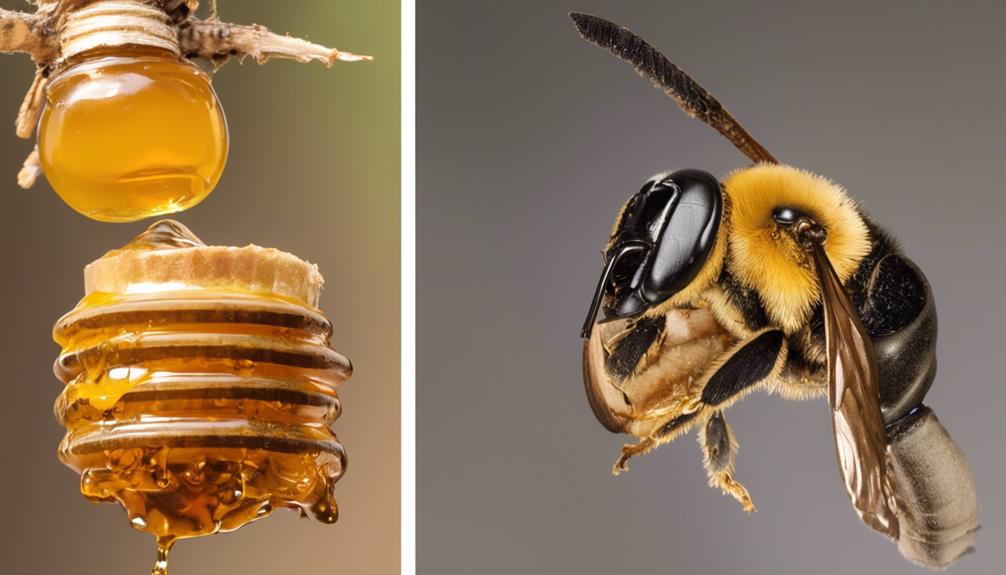
While both carpenter bees and honey bees share a love for nectar and pollen, there are significant differences in their behavior, life cycle, and ecological roles that set them apart.
Carpenter bees are solitary creatures. They don't live in colonies like honey bees, and they don't produce honey or beeswax. Instead, female carpenter bees bore holes into wood to lay their eggs, hence their name. They're also less aggressive than honey bees, unless threatened.
In contrast, honey bees live in highly structured societies, consisting of a queen, workers, and drones. They're known for their honey production, which is a vital food source for them especially during winter. Honey bees also play a crucial role in pollinating various crops and plants, contributing to biodiversity and food production.
However, carpenter bees aren't devoid of ecological importance. While they don't produce honey, they're excellent pollinators. They practice 'buzz pollination,' which involves vibrating flowers until they release pollen. This mechanism is particularly effective for certain plants, making carpenter bees indispensable in some ecosystems.
The Truth About Carpenter Bees and Honey
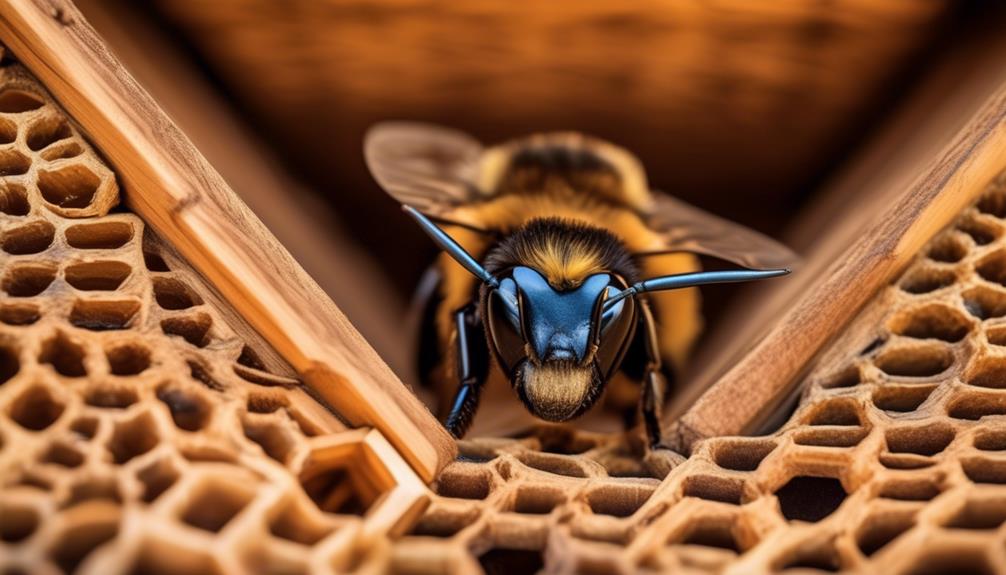
Despite common misconceptions, carpenter bees, in stark contrast to their honey bee counterparts, don't produce honey, a fact that has profound implications for understanding their ecological role and behaviors. While it's easy to lump all bees together, you need to understand the nuances of their biology and lifestyle to truly comprehend this fact.
Carpenter bees are solitary creatures. Unlike honey bees, they don't live in large colonies where the collective labor of many individuals would necessitate a stable food source like honey. Instead, carpenter bees, both males and females, can fend for themselves. They feed on nectar and pollen from flowers, using their long tongues to reach inside.
Moreover, the physical structure of a carpenter bee doesn't support honey production. Their nests, typically burrows in wood, lack the communal hive structure needed for storing and processing large amounts of honey. They don't have the wax glands used by honey bees to construct honeycombs.
Understanding this truth is vital for managing these species and their habitats. Misconceptions about carpenter bees making honey can lead to misguided conservation efforts. Recognizing their unique ecological place ensures the preservation of biodiversity.
Impact on the Ecosystem
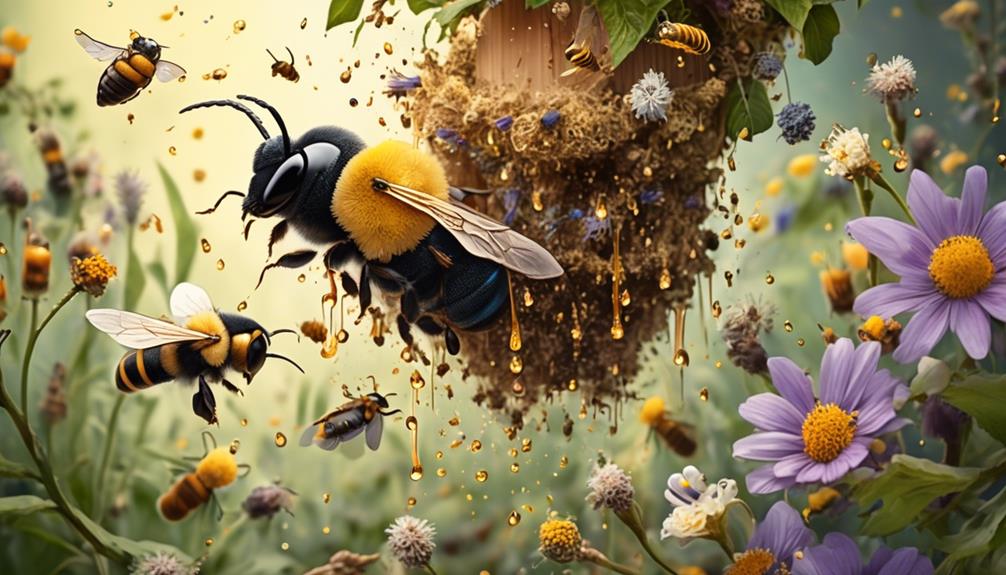
In light of understanding that carpenter bees don't produce honey, it's essential to consider their distinct ecological role and impact on the ecosystem. You might think that without honey, these bees are less beneficial than their honey-making counterparts, but that's not the case.
Carpenter bees are solitary bees, meaning they don't live in colonies like honeybees. This lifestyle choice sets them apart in the ecosystem. Their solitary nature encourages genetic diversity as they aren't restricted to mating within a single colony. This diversity is crucial for the resilience of bee populations as a whole.
These bees are also exceptional pollinators. They participate in a process called 'buzz pollination' where they vibrate their bodies at a specific frequency to dislodge pollen. This behavior is particularly effective for certain types of flowers, leading to successful pollination and propagation of these plant species.
Moreover, carpenter bees contribute to the nutrient cycle. Their nesting habits in deadwood help in the decomposition process, returning nutrients back into the soil. This activity is essential for maintaining healthy soil conditions.
Frequently Asked Questions
What Are Some Effective Methods to Prevent Carpenter Bees From Nesting in Wooden Structures?
To prevent carpenter bees from nesting in your wooden structures, you'll need to take a two-pronged approach.
First, apply a borate-based pesticide to the wood. This will deter the bees and kill any larvae.
Second, seal any existing holes with a wood putty or caulk. It's also helpful to paint or varnish the wood, as carpenter bees prefer untreated surfaces.
Can Carpenter Bees Be Beneficial for Plant Pollination?
Yes, you'll find carpenter bees quite beneficial for plant pollination. They're major pollinators, especially for open-faced flowers. While they burrow into wood to nest, they don't eat it. Instead, they're out gathering pollen and nectar.
This process helps plants reproduce. So, even though they might cause some damage to your wooden structures, they're doing important work for our ecosystem.
How Can You Distinguish Carpenter Bees From Other Similar Species?
You can distinguish carpenter bees from other species by examining their appearance and behavior. They're typically larger, with a shiny, black, hairless abdomen, unlike bumblebees which have hairy, yellow-striped ones.
You'll also notice they're solitary, not living in hives like honeybees. Plus, they have a unique habit of drilling into wood to nest, hence their name.
Understanding these characteristics, you'll easily spot a carpenter bee!
What Are Some Common Misconceptions About Carpenter Bees?
One common misconception you might've about carpenter bees is that they're harmful to humans. In reality, they're generally harmless and rarely sting.
Another is that they're destructive to all wood structures. They do burrow into wood, but usually don't cause significant damage.
Lastly, it's often wrongly assumed they produce honey. Unlike honeybees, carpenter bees don't make honey. They're solitary bees, not hive-dwellers, so they've no need to store food.
Do Carpenter Bees Have Any Natural Predators?
Yes, carpenter bees do have natural predators. You'll find that birds, particularly woodpeckers, are common predators. They're attracted to the larvae inside the wooden tunnels.
Insects like beetles and flies also prey on carpenter bee larvae. Certain species of wasps are known to attack adult bees.
Predation, thus, is a significant challenge these insects face, impacting their survival and population dynamics.
Conclusion
So, you've learned that carpenter bees don't produce honey like their cousins, the honey bees. Their diet of nectar and pollen doesn't necessitate it.
Despite their lack of honey production, they play a crucial role in pollinating our ecosystem. So, don't be too quick to shoo away these industrious insects; they're just as important to our environment, even without the sweet treat.

